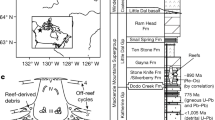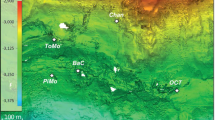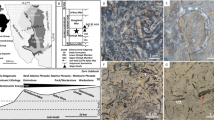Abstract
Microbialites are organosedimentary structures that can be constructed by a variety of metabolically distinct taxa1. Consequently, microbialite structures abound in the fossil record, although the exact nature of the biogeochemical processes that produced them is often unknown2. One such class of ancient calcareous structures3,4,5, Epiphyton and Girvanella, appear in great abundance during the Early Cambrian. Together with Archeocyathids, stromatolites and thrombolites, they formed major Cambrian reef belts. To a large extent, Middle to Late Cambrian reefs are similar to Precambrian reefs6, with the exception that the latter, including terminal Proterozoic reefs7, do not contain Epiphyton or Girvanella. Here we report the discovery in Pavilion Lake, British Columbia, Canada, of a distinctive assemblage of freshwater calcite microbialites, some of which display microstructures similar to the fabrics displayed by Epiphyton and Girvanella. The morphologies of the modern microbialites vary with depth, and dendritic microstructures of the deep water (>30 m) mounds indicate that they may be modern analogues for the ancient calcareous structures. These microbialites thus provide an opportunity to study the biogeochemical interactions that produce fabrics similar to those of some enigmatic Early Cambrian reef structures.
This is a preview of subscription content, access via your institution
Access options
Subscribe to this journal
Receive 51 print issues and online access
$199.00 per year
only $3.90 per issue
Buy this article
- Purchase on Springer Link
- Instant access to full article PDF
Prices may be subject to local taxes which are calculated during checkout




Similar content being viewed by others
References
Burne, R. V. & Moore, L. S. Microbialites: organosedimentary deposits of benthic microbial communities. Palaios 2, 241–254 (1987).
Riding, R. in Calcareous Algae and Stromatolites (ed. Riding, R.) 55– 87 (Springer, Berlin, 1991).
Ahr, W. M. Paleoenvironment, algal structures, and fossil algae in the Upper Cambrian of Central Texas. J. Sedim. Petrol. 41, 205–219 (1971).
James, N. P. Megablocks of calcified algae in the Cow Head Breccia, western Newfoundland: Vestiges of a Cambro-Ordovician platform margin. GSA Bull. 92, 799–811 (1981).
Read, J. F. & Pfeil, R. W. Fabrics of allochthonous reefal blocks, Shady dolomite (Lower to Middle Cambrian), Virginia Appalachians. J. Sedim. Petrol. 53, 761– 778 (1983).
Grotzinger, J. P. in Controls on Carbonate Platform and Basin Development Vol. 44 (eds Crevello, P. D., Wilson, J. L., Sarg, J. F. & Read, J. F.) 79–106 (SEPM Special Publication, Tulsa, 1989).
Grotzinger, J. P. & Khetani, A. in Abstracts with Programs (Northeast Section) Conference Proceedings Vol. 27 (GSA Publications, Denver, 1995).
Fischl, P. Limestone and Dolomite Resource in B. C. Open File 1992-18 (British Columbia Ministry of Energy, Mines and Petroleum Resources, Geological Survey Branch, Victoria, 1992).
Thompson, J. B. & Ferris, G. F. Cyanobacterial precipitation of gypsum, calcite, and magnesite from natural alkaline lake water. Geology 18, 995– 998 (1990).
Thompson, J. B., Schultze-Lam, S., Beveridge, T. J. & Des Marais, D. J. Whiting events: Biogenic origin due to the photosynthetic activity of cyanobacteria picoplankton. Limnol. Oceanog. 42, 133– 141 (1997).
Halley, R. B. in Stromatolites (ed. Walter, M. R.) 435–445 (Elsevier, Amsterdam, 1976).
Eggleston, J. R. & Dean, W. E. in Stromatolites (ed. Walter, M. R.) 479–488 (Elsevier, Amsterdam, 1976).
Thompson, J. B., Ferris, F. G. & Smith, D. A. Geomicrobiology and sedimentology of the mixolimnion and chemocline in Fayetteville Green Lake, New York. Palaios 5, 52–75 (1990).
Ferris, F. G., Thompson, J. B. & Beveridge, T. J. Modern freshwater microbialites from Kelly Lake, British Columbia, Canada. Palaios 12, 213 –219 (1997).
Bischoff, J. L., Stine, S., Rosenbauer, R. J., Fitzpatrick, J. A. & Stafford, T. W. Ikaite precipitation by mixing of shoreline springs and lake water, Mono Lake, California, USA. Geochim. Cosmochim. Acta 57, 3855– 3865 (1993).
Walter, M. R. Stromatolites and the biostratigraphy of the Australian Precambrian and Cambrian. Spec. Pap. Palaeontol. 11, 103– 104 (1972).
Wray, J. L. Calcareous Algae (Elsevier, Amsterdam, 1977).
Bertrand-Sarfati, J. & Moussine-Pouchkine, A. Evolution and environmental conditions of Conophyton-Jacutophyton associations in the Atar dolomite (upper Proterozoic, Mauritania). Precambr. Res. 29, 207–234 ( 1985).
Edwards, R. L., Chen, J. H. & Wasserburg, G. J. 238U-234U-232Th-232Th systematics and the precise measurement of time over the past 500,000 years. Earth Planet. Sci. Lett. 81, 175–192 (1986).
Chafetz, H. S. & Buczynski, C. Bacterially induced lithification of microbial mats. Palaios 7, 277–293 (1992).
Pratt, B. Epiphyton and Renalcis- diagenetic microfossils from calcification of coccoid blue-green algae. J. Sedim. Petrol. 54, 948–971 (1984).
Lauritzen, S. -E. & Lundberg, J. Calibration of the speleothem delta function: an absolute temperature record for the Holocene in northern Norway. Holocene 9, 659– 669 (1999).
Acknowledgements
We thank the Ts’kw’aylaxw First Nation Tribe and Ocean Pacific Water Sports for their logistical assistance and support. Underwater photographs are courtesy of D. Reid, Ocean Photography. D. F. Blake, L. Duncan and B. Schauer provided technical support. M. Taylor, C. Stack and C. R. Omelon assisted with the identification of cyanobacteria and diatoms. Protection for the unique microbialites in Pavilion Lake is underway through the Protected Areas Strategy (PAS) Goal 2 initiative of the British Columbia provincial government.
Author information
Authors and Affiliations
Corresponding author
Rights and permissions
About this article
Cite this article
Laval, B., Cady, S., Pollack, J. et al. Modern freshwater microbialite analogues for ancient dendritic reef structures . Nature 407, 626–629 (2000). https://doi.org/10.1038/35036579
Received:
Accepted:
Issue Date:
DOI: https://doi.org/10.1038/35036579
This article is cited by
-
Diversified calcimicrobes in dendrolites of the Zhangxia Formation, Miaolingian Series (Middle Cambrian) of the North China craton
Journal of Palaeogeography (2021)
-
Early-earth nonprotein amino acid metabolites in modern cyanobacterial microbialites
Environmental Chemistry Letters (2020)
-
Calcified cyanobacteria fossils from the leiolitic bioherm in the Furongian Changshan Formation, Datong (North China Platform)
Carbonates and Evaporites (2019)
-
Inner workings of thrombolites: spatial gradients of metabolic activity as revealed by metatranscriptome profiling
Scientific Reports (2015)
-
Using Mg Isotopes to Trace Cyanobacterially Mediated Magnesium Carbonate Precipitation in Alkaline Lakes
Aquatic Geochemistry (2013)
Comments
By submitting a comment you agree to abide by our Terms and Community Guidelines. If you find something abusive or that does not comply with our terms or guidelines please flag it as inappropriate.



